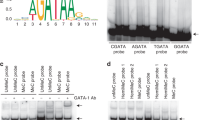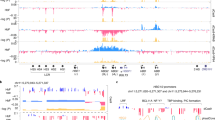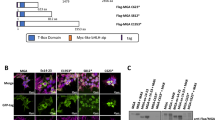Abstract
Hemgn (a gene symbol for hemogen in mouse, EDAG in human and RP59 in rat) encodes a nuclear protein that is highly expressed in hematopoietic tissues and acute leukemia. To characterize its regulatory mechanisms, we examined the activities of a Hemgn promoter containing 2975 bp of 5′ flanking sequence and 196 bp of 5′ untranslated region (5′ UTR) sequence both in vitro and in vivo: this promoter is preferentially activated in a hematopoietic cell line, not in nonhematopoietic cell lines, and is sufficient to drive the transcription of a lacZ transgene in hematopoietic tissues in transgenic mice. Mutagenesis analyses showed that the 5′ UTR including two highly conserved GATA boxes is critical for the promoter activity. GATA1, not GATA2, binds to the GATA binding sites and transactivates the Hemgn promoter in a dose-dependent manner. Furthermore, the expression of human hemogen (EDAG) transcripts were closely correlated with levels of GATA1 transcripts in primary acute myeloid leukemia specimens. This study suggests that the Hemgn promoter contains critical regulatory elements for its transcription in hematopoietic tissues and Hemgn is a direct target of GATA1 in leukemia cells.
This is a preview of subscription content, access via your institution
Access options
Subscribe to this journal
Receive 12 print issues and online access
$259.00 per year
only $21.58 per issue
Buy this article
- Purchase on Springer Link
- Instant access to full article PDF
Prices may be subject to local taxes which are calculated during checkout






Similar content being viewed by others
Accession codes
References
Yang LV, Nicholson RH, Kaplan J, Galy A, Li L . Hemogen is a novel nuclear factor specifically expressed in mouse hematopoietic development and its human homologue EDAG maps to chromosome 9q22, a region containing breakpoints of hematological neoplasms. Mech Dev 2001; 104: 105–111.
Lu J, Xu WX, Wang SY, Zhan YQ, Jiang Y, Cai WM et al. Isolation and Characterization of EDAG-1, A Novel Gene Related to Regulation in Hematopoietic System. Sheng Wu Hua Xue Yu Sheng Wu Wu Li Xue Bao 2001; 33: 641–646.
Kruger A, Ellerstrom C, Lundmark C, Christersson C, Wurtz T . RP59, a marker for osteoblast recruitment, is also detected in primitive mesenchymal cells, erythroid cells, and megakaryocytes. Dev Dyn 2002; 223: 414–418.
Li CY, Zhan YQ, Xu CW, Xu WX, Wang SY, Lv J et al. EDAG regulates the proliferation and differentiation of hematopoietic cells and resists cell apoptosis through the activation of nuclear factor-kappa B. Cell Death Differ 2004; 11: 1299–1308.
Lu J, Xu WX, Wang SY, Jiang Y, Li CY, Cai WM et al. Overexpression of EDAG-1 in NIH3T3 cells leads to malignant transformation]. Sheng Wu Hua Xue Yu Sheng Wu Wu Li Xue Bao (Shanghai) 2002; 34: 95–98.
An LL, Li G, Wu KF, Ma XT, Zheng GG, Qiu LG et al. High expression of EDAG and its significance in AML. Leukemia 2005; 19: 1499–1502.
Perry C, Soreq H . Transcriptional regulation of erythropoiesis. Fine tuning of combinatorial multi-domain elements. Eur J Biochem 2002; 269: 3607–3618.
Evans T, Reitman M, Felsenfeld G . An erythrocyte-specific DNA-binding factor recognizes a regulatory sequence common to all chicken globin genes. Proc Natl Acad Sci USA 1988; 85: 5976–5980.
Patient RK, McGhee JD . The GATA family (vertebrates and invertebrates). Curr Opin Genet Dev 2002; 12: 416–422.
Ohneda K, Yamamoto M . Roles of hematopoietic transcription factors GATA-1 and GATA-2 in the development of red blood cell lineage. Acta Haematol 2002; 108: 237–245.
Mayor C, Brudno M, Schwartz JR, Poliakov A, Rubin EM, Frazer KA et al. VISTA: visualizing global DNA sequence alignments of arbitrary length. Bioinformatics 2000; 16: 1046–1047.
Ge Y, Jensen TL, Stout ML, Flatley RM, Grohar PJ, Ravindranath Y et al. The role of cytidine deaminase and GATA1 mutations in the increased cytosine arabinoside sensitivity of Down syndrome myeloblasts and leukemia cell lines. Cancer Res 2004; 64: 728–735.
Drexler HG . The leukemia-lymphoma cell lines factsbook. Academic Press: San Diego California USA, 2001, pp 646–647.
Ge Y, Jensen TL, Matherly LH, Taub JW . Transcriptional regulation of the cystathionine-beta-synthase gene in Down syndrome and non-Down syndrome megakaryocytic leukemia cell lines. Blood 2003; 101: 1551–1557.
Ge Y, Stout ML, Tatman DA, Jensen TL, Buck S, Thomas RL et al. GATA1, cytidine deaminase, and the high cure rate of Down syndrome children with acute megakaryocytic leukemia. J Natl Cancer Inst 2005; 97: 226–231.
Nordeen SK . Luciferase reporter gene vectors for analysis of promoters and enhancers. Biotechniques 1988; 6: 454–458.
Crossley M, Tsang AP, Bieker JJ, Orkin SH . Regulation of the erythroid Kruppel-like factor (EKLF) gene promoter by the erythroid transcription factor GATA-1. J Biol Chem 1994; 269: 15440–15444.
Anderson KP, Crable SC, Lingrel JB . Multiple proteins binding to a GATA-E box-GATA motif regulate the erythroid Kruppel-like factor (EKLF) gene. J Biol Chem 1998; 273: 14347–14354.
Anderson KP, Crable SC, Lingrel JB . The GATA-E box-GATA motif in the EKLF promoter is required for in vivo expression. Blood 2000; 95: 1652–1655.
Qiu P, Feng XH, Li L . Interaction of Smad3 and SRF-associated complex mediates TGF-beta1 signals to regulate SM22 transcription during myofibroblast differentiation. J Mol Cell Cardiol 2003; 35: 1407–1420.
Yang LV, Heng HH, Wan J, Southwood CM, Gow A, Li L . Alternative promoters and polyadenylation regulate tissue-specific expression of Hemogen isoforms during hematopoiesis and spermatogenesis. Dev Dyn 2003; 228: 606–616.
Schwartzbauer G, Schlesinger K, Evans T . Interaction of the erythroid transcription factor cGATA-1 with a critical auto-regulatory element. Nucleic Acids Res 1992; 20: 4429–4436.
Wall L, deBoer E, Grosveld F . The human beta-globin gene 3′ enhancer contains multiple binding sites for an erythroid-specific protein. Genes Dev 1988; 2: 1089–1100.
Ko LJ, Engel JD . DNA-binding specificities of the GATA transcription factor family. Mol Cell Biol 1993; 13: 4011–4022.
Cantor AB, Orkin SH . Transcriptional regulation of erythropoiesis: an affair involving multiple partners. Oncogene 2002; 21: 3368–3376.
Pedone PV, Omichinski JG, Nony P, Trainor C, Gronenborn AM, Clore GM et al. The N-terminal fingers of chicken GATA-2 and GATA-3 are independent sequence-specific DNA binding domains. EMBO J 1997; 16: 2874–2882.
Testa U . Apoptotic mechanisms in the control of erythropoiesis. Leukemia 2004; 18: 1176–1199.
Fujiwara Y, Chang AN, Williams AM, Orkin SH . Functional overlap of GATA-1 and GATA-2 in primitive hematopoietic development. Blood 2004; 103: 583–585.
Fujiwara Y, Browne CP, Cunniff K, Goff SC, Orkin SH . Arrested development of embryonic red cell precursors in mouse embryos lacking transcription factor GATA-1. Proc Natl Acad Sci USA 1996; 93: 12355–12358.
Acknowledgements
We appreciate the access to microscopes in Dr Richard Vander Heide's laboratory and the Imaging Core Facilities of Karmanos Cancer Institute at Wayne State University. We thank Dr Giuseppe Rossi and Scott Goustin for helpful discussions. This work was supported by a grant from the Children's Research Center of Michigan (to L Li), the seed grant from the department of Internal Medicine at Wayne State University (to L Li), NHLBI/NIH HL58916 (to L Li), NCI Grant RO1 CA92308 (to JW Taub), NCI Grant RO1 CA76641 (to L Matherly), the Leukemia and Lymphoma Society (to JW Taub), and the Children's Research Center of Michigan (to Y Ge).
Author information
Authors and Affiliations
Corresponding author
Additional information
Supplementary Information is available on the Leukemia website (http://www.nature.com/leu/)
Supplementary information
Rights and permissions
About this article
Cite this article
Yang, L., Wan, J., Ge, Y. et al. The GATA site-dependent hemogen promoter is transcriptionally regulated by GATA1 in hematopoietic and leukemia cells. Leukemia 20, 417–425 (2006). https://doi.org/10.1038/sj.leu.2404105
Received:
Accepted:
Published:
Issue Date:
DOI: https://doi.org/10.1038/sj.leu.2404105
Keywords
This article is cited by
-
N6-methyladenosine mRNA marking promotes selective translation of regulons required for human erythropoiesis
Nature Communications (2019)
-
The over-expression of aquaporin-1 alters erythroid gene expression in human erythroleukemia K562 cells
Tumor Biology (2015)
-
Models of haematopoiesis: seeing the wood for the trees
Nature Reviews Immunology (2009)
-
Overexpression of a hematopoietic transcriptional regulator EDAG induces myelopoiesis and suppresses lymphopoiesis in transgenic mice
Leukemia (2007)



